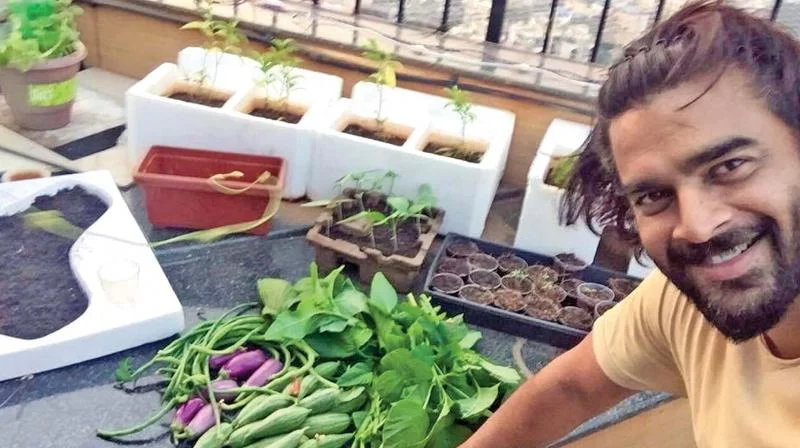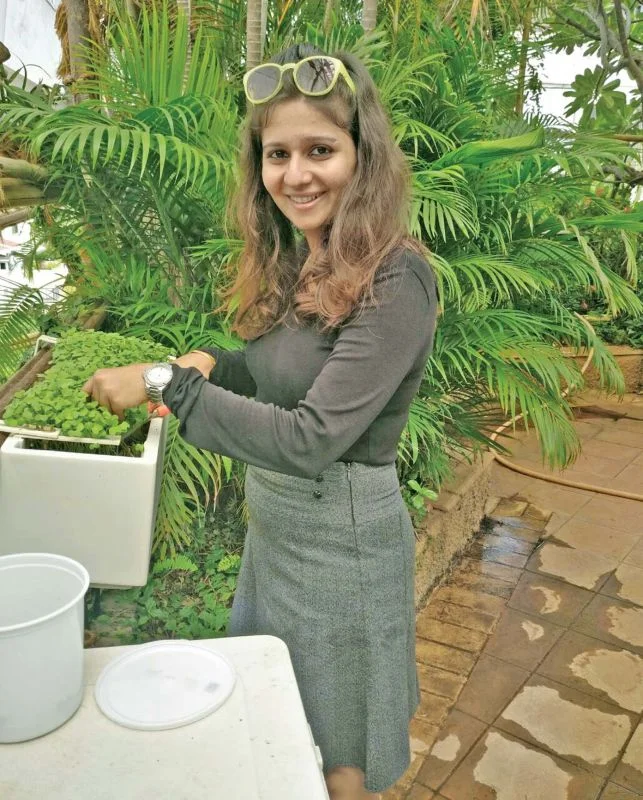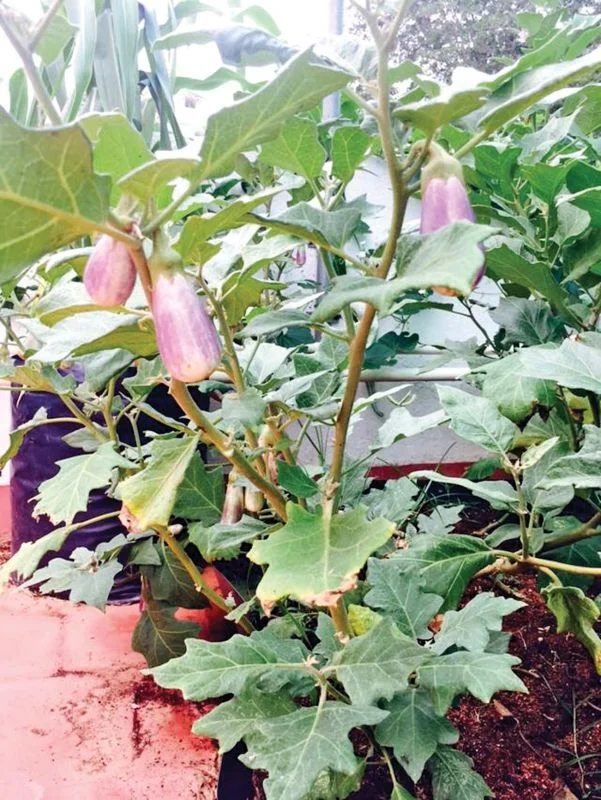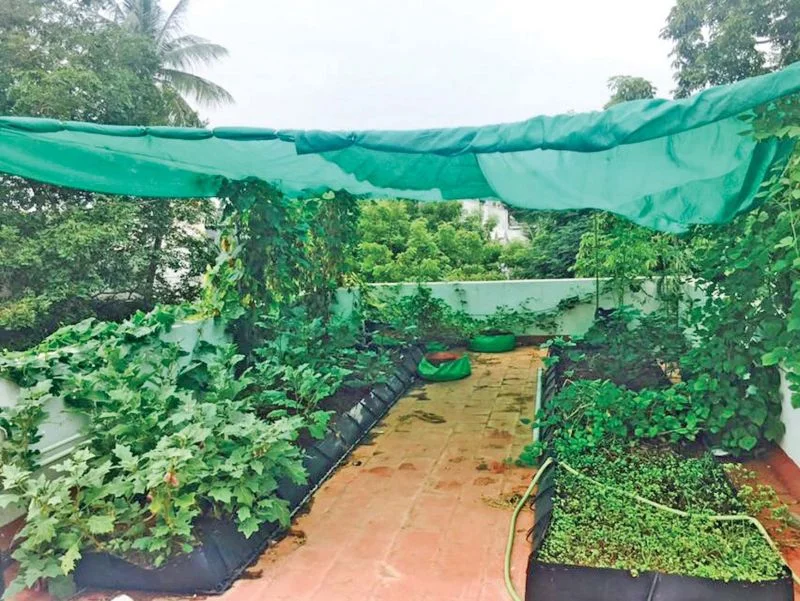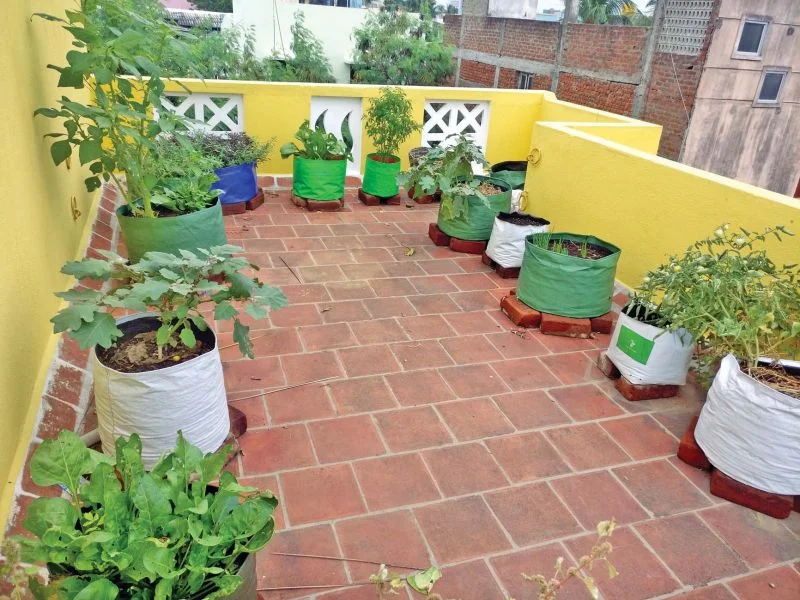
Welcome to iGrow News, Your Source for the World of Indoor Vertical Farming
This Hidden U Of T Rooftop Farm Helps Feed the Hungry—and Could Impact How Cities Eat
Plus, find out how some U of T alumni are keeping the project alive.
By Kimberly Lyn
To feed Toronto, we must import more than 6000 tonnes of food every single day. As a result, more than 30 per cent of Toronto's environmental footprint is food-related—including the impact of shipping, pesticides and packaging. In fact, Toronto's food footprint affects the environment even more than its car traffic. And the reliance on imports also comes with a social cost: for those in poverty, fresh, organic produce can be hard to access.
But atop an engineering building at the University of Toronto, students are conducting a living experiment in doing food differently: one of the city's biggest and most innovative food-producing rooftop gardens.
For more than eight years, Sky Garden's student and alumni volunteer farmers have planted, watered, weeded, and harvested produce on the bright, windswept rooftop of U of T's Galbraith Building. Their yield clocks in at an impressive 500 pounds of fresh, organic produce a year, and they send more than half of it directly to nearby Scott Mission—so that people in need can receive hot meals made with organic, locally grown produce.
“The garden takes inanimate concrete and transforms it into something that’s growing things,” says Matt Stata, a PhD student in the department of ecology and evolutionary biology, who helps oversee the project.
“It’s an example of what's possible,” says Stata. “There are so many unused roof spaces in Toronto that could be producing food... and so many people who would love to garden, but don't have any space to do it. And the people at Scott Mission are ecstatic when we bring over bags and bags of fresh produce. There's a real need.”
That vision is shared by U of T's affinity partners and alumni, who help fund the Sky Garden project. When alumni use a U of T MBNA credit card, or sign up for insurance through Manulife or TD Insurance, these affinity partners contribute a portion of the proceeds to Sky Garden—as well as to other key U of T alumni and student initiatives that are making an impact on our community.
Sky Garden's unique containers
Sky Garden is catching on: its volunteers have been called on to help set up similar rooftop gardens for other Toronto buildings and residences.
Rooftop gardens are a compelling idea because they offer all the benefits of a conventional green roof—stormwater retention, heat reduction, and air quality improvement—but with the added benefits of producing food, building a stronger sense of community, and helping connect people to food, nature, and each other.
Of course, farming on a roof comes with its challenges. Sky Garden's volunteer farmers use special, lightweight semi-hydroponic containers (featuring only a thin layer of soil) instead of covering the whole roof in soil, to ensure the farm doesn't exceed the roof's weight limit—since older roofs like Galbraith's can only bear so much.
They've also learned to cultivate shorter plants, as tall plants such as sunflowers can be bowled over by the strong rooftop wind. "We're actually growing corn this year," Stata says, "but it's a dwarf variety."
Sky Garden volunteers, Cindy and Matt.
Plus, not all produce works out. "We can't seem to grow kale," Stata muses. "We don't get too many pests up here, but for some reason, aphids just go bonkers for our kale."
But with every year that passes, the students have learned more and more about rooftop farming.
Give pumpkins and squash a few buckets to stretch out in, like they would in a real field.
Rip out plants as soon as they've stopped producing, and replace them with ones that are ready to produce—that way you use your containers more efficiently, and get a much bigger yield.
And don't even think about hand-watering and hand-fertilizing—it might work for a small garden, but it isn't viable for a farm of Sky Garden's size. Instead, the students installed an automated drip irrigation system, so each plant can suck up as much fertilized water as it needs, without drowning or drying out.
Sky Garden has also become a hub for other urban agricultural experiments. It's home to a year-round beekeeping operation, a solar-powered fruit dehydrator, and an array of unusual and heirloom produce—from ghost-white pumpkins to blue (yes, blue) tomatoes.
Sky Garden tomatoes. Photo by Jesse Milns
Student farmers are also trained in seed collection and preservation, and are encouraged to grow their own pet projects. In 2018, Sky Garden is hosting a student's struggling goji berry plant, testing out baby bok choy, and tackling their very first crop of mushrooms—grown in buckets of used coffee grounds, acquired "from a deal we struck with the local Second Cup," says Stata.
And the results have been mouth-watering. "There's a noticeable difference between our melons and grocery store melons," says Stata. "By letting our melons ripen on the vine, they're so much sweeter."
But the sweetest thing of all, according to Stata?
"Seeing how excited the students are to learn."
When you use U of T alumni financial services, you support Sky Garden too. Learn more »
Company Finds New Way to Grow Lettuce, Cut Risk of Foodborne Illness
One rooftop greenhouse company in Chicago says their lettuce is safer and longer-lasting.
3:25 PM, Dec 5, 2018
4:16 PM, Dec 6, 2018
The romaine lettuce outbreak has many consumers thinking about where their crops are grown.
One rooftop greenhouse company in Chicago says their lettuce is safer and longer-lasting.
Jenn Frymark, the chief agriculture officer and manager of Gotham Greens, pulls out a head of lettuce and immediately starts to eat it.
"No, you don't need to wash it,” Frymark says. “We don't have that on our package, but there's no reason for me to wash it. I never wash any of our lettuce at home. It's amazing; nothing touches it; it’s so clean.”
Here at Gotham Greens, lettuce is grown differently.
They do it hydroponically. That means it’s grown without soil, but in a nutrient-rich water. Instead of a traditional farm field, this lettuce is grown on rooftop greenhouses.
Their space on Chicago's south side is the largest rooftop greenhouse in the country. Because of the controlled environment, crops can grow in a third of the time of a traditional field.
“We're giving this plant everything it wants: the right day temp, the right night temp, the nutrients, CO2 levels, air circulation, the water,” Frymark explains. “I mean, these are very coddled plants and they have everything they need, and they can just grow in this perfect environment and reach maturity very quickly.”
Gotham Greens sells to grocery stores in the Chicago and New York metro areas, as well as select Whole Foods stores. The product goes from the greenhouse directly to grocery shelves in a day and a half.
The company’s lettuce also lasts longer than the traditional grocery lettuce out here. Frymark says their product can last up to two to three weeks in the fridge. Additionally, Gotham Greens prices are comparable to other organic produce.
Frymark also says their method dramatically lowers the risk for foodborne illness.
“There [are] no manures, there’s no water sources that could be contaminants,” she says. “We don't have birds and animals getting into the field.”
She says the company is expanding and plans to open more rooftop greenhouses in the near future.
Greenroofs.com Featured Project October 15, 2018
Skool4Kidz Campus @ Sengkang Riverside Park
30,138 sf Greenroof
Singapore
Greenroofs.com Featured Project October 15, 2018
I had selected the Skool4Kidz Campus @ Sengkang Riverside Park as one outstanding project that just had to be included in my “Greenroofs.com 2018 Top 10 List of Hot Trends in Greenroof & Greenwall Design” long before I recently received a Project Submission from our friends over at Elmich Pte Ltd in Singapore.
Its stunning, curved, and joyous greenroof just screamed at me – plus it looks like a juicy multi-colored caterpillar!
Photo: Elmich
I shouldn’t be glib about it, but it’s hard not to find a wonderful greenroof or greenwall project in Singapore.
With extreme governmental support to provide healthier living spaces in the tight quarters of the very built-up island nation and create a City in a Garden, it’s no wonder their plans are to have 200 hectares of greenroofs and walls in place by 2030 -that’s 2 million m2!
Photo: Darren Soh, Freight Architects
Mini Description & Details
Situated in the middle of a highly developed and built-up area, the new Skool4Kidz Campus @ Sengkang Riverside Park preschool is the largest childcare center to be located within a public park in Singapore. It’s also the first collaboration between the Early Childhood Development Agency and the National Parks Board.
Designed by Freight Architects, the flagship 4,000 square meter complex is not only an architectural work of art but is imbued with biodiversity, inside and out.
Image: Freight Architects
Photo: Elmich
The nature-focused campus is designed to integrate seamlessly into the green surroundings of the park in order to keep the children in touch with nature, providing them with a safe and nurturing environment for their holistic development.
Resembling a “green cocoon,” the 2-story green roof is supported by steel ribs that open up towards the edges, merging into the landscape. Perforated by skylights and left open on the ground and second levels, the structure provides fresh air and dappled natural light indoors.
Photo above and below: Chng Shao Kai/TODAY
Due to the heavy structural load of the barrel-shaped roof, a lightweight, flexible, and erosion-proof design was required, as well as good thermal insulation properties. The Elmich green roof system was selected and to enhance drainage capabilities, Elmich’s VersiCell® drainage cells were placed underneath the planting boards and beneath a layer of geotextile.
Planted with twelve different species, the lush landscaping was implemented by Nature Landscapes. A Garden Atrium houses indoor trees, shrubs, an eco-garden, and a sky bridge, and children can learn about different flora and fauna.
Herbs grown in the eco-garden are cooked and served in the kids’ meals, giving them a unique “garden to table” culinary experience. To promote sustainability, rainwater is also harvested for irrigation and learning purposes.
The beautiful Skool4Kidz Campus @ Sengkang Riverside Park green roof is designed to thrive year round in Singapore’s tropical weather and encourage healthy and strong, socially-emotionally confident, and environmentally responsible children.
Photo: Skool4Kids Facebook
Photo: Elmich
Year: 2018
Owner: Skool4Kidz Pte
Location: Singapore
Building Type: Educational
Greenroof Type: Extensive
System: Single-Source
Size: 30,138 sf
Slope: 3-45%
Access: Inaccessible
Privacy: Public
Credits:
ARCHITECT: FREIGHT ARCHITECTS LLP
GREEN ROOF SYSTEM PROVIDER: ELMICH PTE LTD
GREEN ROOF IMPLEMENTATION: NATURE LANDSCAPES PTE LTD
DESIGN AND BUILD MAIN CONTRACTOR: SANWAH CONSTRUCTION PTE LTD
C&S CONSULTANT: KCL CONSULTANTS PTE LTD
Image: Skool4Kids Facebook
All the Info:
View the Skool4Kidz Campus @ Sengkang Riverside Park project profile to see ALL of the Photos and Additional Information about this particular project in the Greenroofs.com Projects Database.
Photo: Darren Soh, Freight Architects
Featured Project
Watch the Skool4Kidz Campus @ Sengkang Riverside Park Featured Project Video above or see it on our GreenroofsTV channel on YouTube.
Did we miss your contribution? Please let us know to add you to the Skool4Kidz Campus @ Sengkang Riverside Park profile.
Would you like one of your projects to be featured on Greenroofs.com? We have to have a profile first! Submit Your Project Profile.
Love the Earth, Plant a Roof or Wall!
By Linda S. Velazquez, ASLA, LEED AP, GRP
Greenroofs.com Publisher & Greenroofs & Walls of the World™ Virtual Summits Host
When Balconies And Backyards Turn Green
When Balconies And Backyards Turn Green
DECCAN CHRONICLE. | BALAJEE C R
Published | Oct 1, 2017
The concept of urban farming is a hit with today’s generation.
Actor R. Madhavan engaging actively in urban farming at his house. (Photo: DC)
This millennial quit his high-paying job… to start a farm!’ Clickbait as they may be, there’s no denying that the phenomenon of urban farming has well and truly captured the fancy of the Gen Y today. Call it a hark back to the roots, or an innate sense of triggering one’s green thumb, the fact remains that several young professionals find small-scale agriculture an amateur interest or in many cases, even an alternate career option. From judiciously-researched plots of land to terraces and backyards, these social entrepreneurs are leaving no stone unturned (literally!) to ensure local agriculture becomes an intrinsic part of their lives.
Be it an individual, a group of friends or a small neighbourhood/ community with a sense of purpose, the activity is touted as a way to increase access to locally-grown food and bring to light again, the many benefits of food that have gotten lost over time. After years of having no say in how their food is grown or where it comes from, urban farming is helping the modern-day consumer be better informed — and healthier!
Growing awareness on healthy eating has certainly aided in people taking urban farming more seriously. Support from multiple organisations has also helped the general public overcome certain limitations — space, for instance is no more an issue (certain herbs can now be grown in a 10-inch pot) and some enterprises even exist to help people set up base in their homes.
Urban farms could be set up for various reasons — as a hobby, for education or training, or for profit. For many, it’s a method to preserve traditional food philosophy, while for yet others, it provides a sense of ‘food justice’ — which is exercising their right to grow, sell and improve access to culturally-appropriate food, which is grown locally and affordable.
Rise of urban farming in the country
Priyanka Amar Shah, the founder of Mumbai-based iKheti, a community enterprise that promotes sustainable urban farming, feels that the concept of farming in cities has been in practice for many years — but only in an informal manner.
Priyanka Amar Shah, founder of iKheti engaging actively in urban farming at her house. (Photo: DC)
“It’s very pleasing to see urban farming being considered more than just a hobby now. Because what we believe is that this activity can be something that can be a social enterprise — and even provide employment opportunities. When we’re talking about changes in the environment, we are not going to come up with solutions unless or otherwise it’s not taken into a bigger level and not just as pastime. People have never been so concerned about environmental issues earlier — it’s affecting all of us and the nature as well,” muses Priyanka.
Archana Stalin, founder of myHarvest, a Chennai-based initiative, which encourages people to grow what they eat, says that she has had continuous phone calls over the past few months. “All of them are queries about how to set up terrace or kitchen gardens in their apartments within the city! When we started off, the concept of urban farming was in its nascent stage. But now, the idea has got a lot of attention and people are really taking to these projects like a house on fire!” she says proudly.
The desire to eat healthy
Priya Thalur Balaji, wife of former international cricketer Lakshmipathy Balaji, says that she was inspired to take up urban farming so that her family could eat healthy.
(Photo: Mommy Shots by Amrita)
“When I thought of feeding solids to my son for the first time, I was very particular that I give him healthy vegetables, but I wasn’t sure how hygienic the ones we get in the markets are. I had a plan of what to feed him around the time he was ready to eat solids. So I started sowing seeds for those vegetables — like spinach, tomatoes and more. Right now I have brinjal, corn, ginger mint, coriander — and vegetables for daily use like tomatoes, snake guard, bottle guard, drumstick and I have just sowed basil.”
Archana, who has a similar point-of-view, states, “Unlike earlier, people have become extra-conscious about their health. It has become an utmost priority now and the result is a major upsurge in the organic food industry. More people have switched to buying organic food items and the demand has increased. Rather than relying on the ‘labeled’ organic vegetables from the market, the wiser lot has decided to grow their own produce. That’s how there is a boom in organic farming. What I have noticed is that parents want to grow veggies and feed their kids home-grown, pesticide-free food. Not just getting the yield, parents want their kids to get exposed to farming at a younger age. It’s a good sign that shows people’s attitude towards farming is changing.”
Priya Thalur Balaji’s terrace farm (Photo: DC)
Priya Thalur Balaji’s terrace farm (Photo: DC)
Ideal crops to cultivate
Though it isup to one’s own choices and preferences, there are certain factors to keep in mind while indulging in urban farming. Priyanka advises first-time gardeners to not directly jump to vegetables — “Because it takes a longer time to grow. So we always suggest people to start with herbs — like lemon grass, curry patta, ajwain and more because all these have health benefits and they are also used in houses every day. With people now interested in cuisines like Italian, continental etc., one can also grow Italian basil, oregano, celery; the best part about herbs is that they’re also available as saplings rather than just as seeds. Once you’re used to this, you can then move on to vegetables.”
She adds, “I don’t feel space is an issue anymore; right now, in Mumbai for instance, there a lot of grills in houses — grill planters, railing planters available at many places. The herbs that I’m talking about don’t even require that much space — you can easily grow them in a 10-inch pot.”
Eldho Pachilakkadan, a restaurateur from Kochi, believes only in raw diet and fruit diet. In order to meet his particular dieting needs, he set up a 40-acre farm in Idukki and grows about 200 varieties of fruit vegetables. What are the ideal fruit trees to grow in cities, we ask him?
Eldho Pachilakkadan (Photo: DC)
The 38-year-old says, “I understand there are many limitations, but I feel people can at least grow four trees in their homes. I feel banana and papaya are the ideal ones to grow in houses.”
Spinach is also considered to be one of the most ideal ones to cultivate. “My advice for people is that they should start with spinach — it’s easier to grow and it’s very nutritious. But I think tomatoes, ladies finger and brinjal are the three veggies that people love to plant,” Archana claims.
On the other hand, Priya says that one should be focusing on cultivating crops that are needed on a daily basis — “For people, who have a balcony or terrace space, it’s easy to grow basic essentials like spinach, coriander and ginger mint — these are something that we use on a everyday basis.”
Social media to the rescue
The active online community on social media as well, ensures that more and more beginners enter the field every year. For instance, Bengaluru-based techie, Srikant Kapungati, considers himself a mentor of sorts on the Facebook group ‘Organic Terrace Gardening’ where he routinely guides novices in the field on the dos and don’ts of the hobby/ alternate career. Srikant himself got into the habit less than four years ago, quite by accident.
Bengaluru-based techie Srikant Kapungati at his terrace garden. (Photo: DC)
“I have a weird reason for getting into organic farming; I wanted to do something with the terrace space in my house, and the idea of a garden somehow randomly came to mind! Maybe there was a hidden gene from my forefathers inside me, which propagated my green thumb; I took to it instantly. At the same time, how avidly you approach this depends a lot on the individual and the circumstances,” says Srikant.
A couple of years later, he really wanted to make sure other aspirants across India wouldn’t have to go through random websites or purchase gardening books when setting up their first OTG — “So I wrote a series of blog posts, explaining the basic equipment and facilities needed for a first project, from containers to seeds and composting at home, and so on. Also, it’s important that newbies experiment and eventually find their own niche; find what they are good at growing.”
Farming can be therapeutic too!
“As said earlier, I mainly started to engage in urban farming to feed my son, but I found the practice very interesting and it is also very therapeutic for me in one way — while handling the baby, I needed time for myself and gardening is now giving me the calm I wanted. I started a year and a half ago, but I’ve not even lost a bit of interest — everyday, every vegetable is teaching me something new!” shares Priya.
Time constraints are a many, but Srikant ensures he gets his fill of gardening every morning before he rushes off to work —- “It can be a real stress-buster, but there are people who take it very seriously and it adds to their pressure too! So it’s important to sort our priorities always. These days, I stick to growing greens rather than veggies, as the former has a lesser and easier cycle.”
Archana Stalin and her terrace garden (Photo: DC)
Not rocket science
Those who’ve been into urban farming, almost unanimously feel that there are not many challenges, but only certain limitations. Eldho says, “I started only a year back, but now I almost have so many varieties of fruit trees — including some exotic varieties like baraba. It’s just simple science — sow seeds or plant a sapling and they grow by themselves! All you need to do is take care of them every day.”
Even Priya opines, “There are not many challenges — I, for sure, didn’t have that many. I didn’t do everything initially on my own; I had a person, who helped me at the beginning. But after first quarter, I understood more — how to add nutrition to the soil, what kind of nutrition one should buy, when one should use organic pesticides and stuff like that. I wouldn’t say I’m all that well-versed now, but I’ve started experimenting with a few vegetables.”
But Priyanka has a slightly different point of view, “We realised that though many people were willing to take to urban farming, they didn’t have right kind of information — which crop to grow in a particular season and more. There is a lack of information and lack of access to raw materials. Even if you go to nurseries, all you’ll get is a show plant or a flowering plant.”
Support from all quarters and corners
For an aspiring urban farmer, there are options aplenty if he/ she needs guidance or support — apart from the horticulture society of India and the help from the government, there are also several initiatives like iKheti, myHarvest and more for people to seek help from in every city across India.”
Priyanka says that enterprises like theirs act as one-stop shop for all the farmers — “Right from the consultancy part, to providing raw materials and the most importance factor of maintenance, everything is taken care of by us.”
“Media has also played a huge role— nowadays a lot has been written, discussed and debated on organic farming. People are also exposed to various forms of farming. Even a lot of companies in cities are coming forward and setting up vegetable gardens in their space. The opportunities now are very good,” says Archana.
Priya also feels that it’s just up to people to go ahead with their passion and everything else will fall in place if one goes about pursuing urban farming properly — “The government and horticulture society help you in setting up the base by providing kits, grow bags and more. So, it is definitely not difficult to kickstart your green dream anymore!”
Maddy’s stint with urban farming
Of course, actors aren’t far away either when it comes to promoting the trend with several converting part of their balconies into gorgeous terrace gardens. In an earlier interview to DC, actor Madhavan, who grows his own vegetables at his house, said, “Saala Khadoos (Irudhi Suttru) was taking a long time to finish and I was bored (laughs), so I started my own kitchen garden to keep myself occupied. Now, I have enough vegetables to keep me fed for at least five days in a week. Since you are growing your own produce, you know what goes in there and what doesn’t.”
Actor R. Madhavan engaging actively in urban farming at his house. (Photo: DC)
He added, “Once you start doing that, you understand the life of those people who grow vegetables to make a living, especially the farmers. If one of my plants gets eaten by a rat, I become very angry! I can imagine what the farmers would be going through when their crops get ruined by pests or weather. One of the most resounding thoughts that keep me bothered is that we wish we can be more compassionate to the plight of farmers.”










